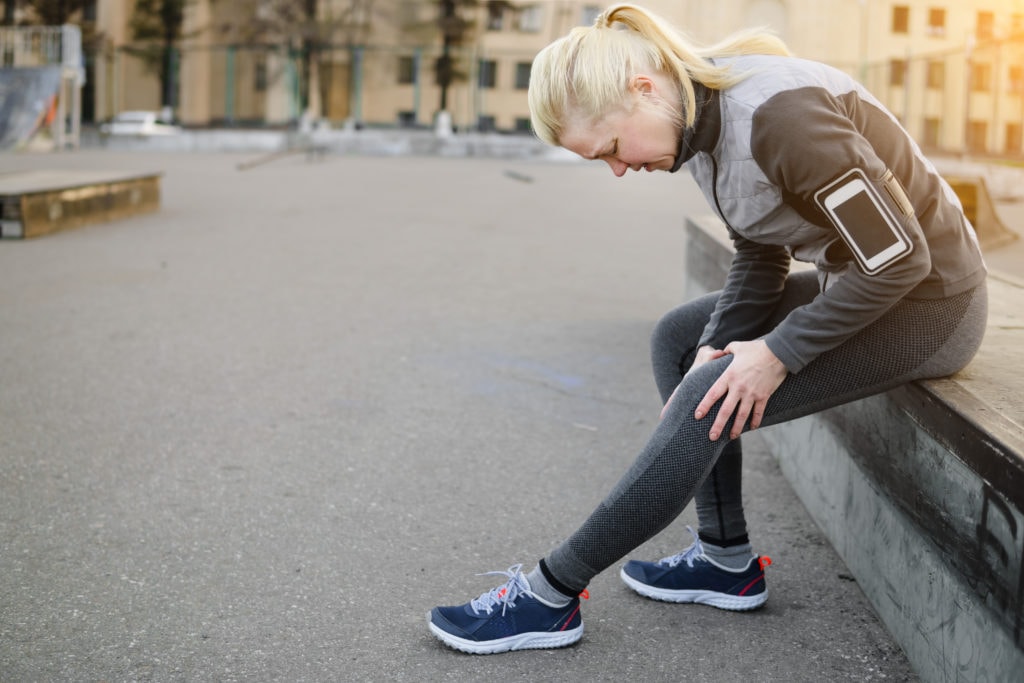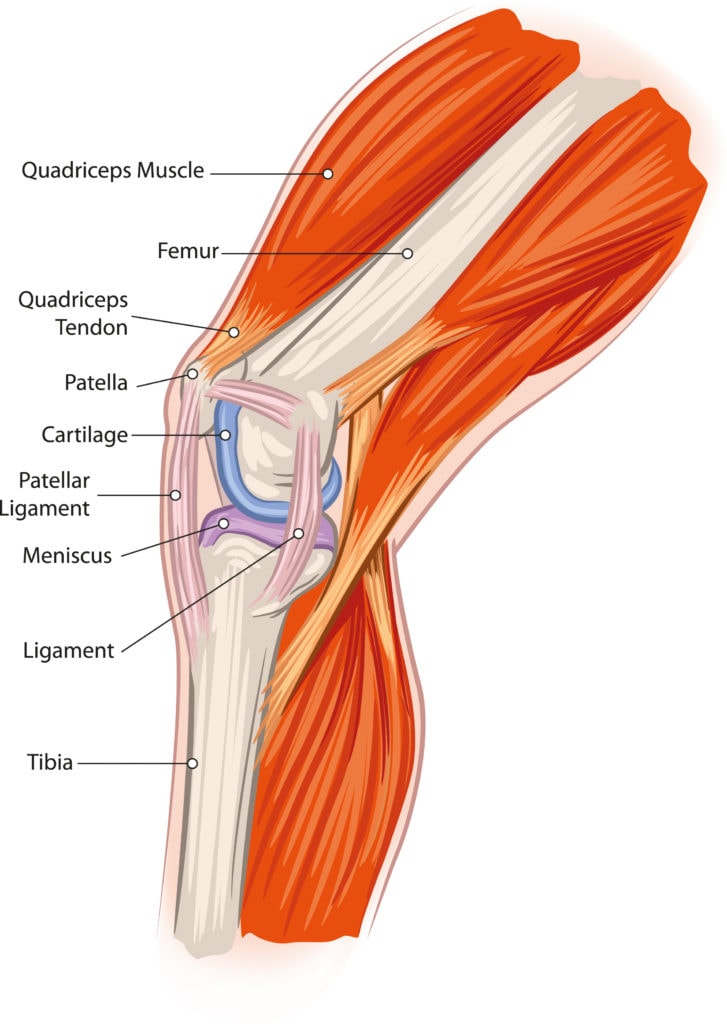Runner’s knee is a common phenomenon not only among runners. The term runner’s knee is kneecap (patella) out of alignment, but also a common term used to describe several injuries or pains around the knee. If you started to suffer any pain in your kneecap area don’t postpone a diagnose. If about to start regular long duration exercises, it is essential for you to be aware of related knowledge in advance. Let’s cover the runner’s knee symptoms, causes, and treatment, for prevention or fast recovery.

Your pain around knee cap derives from several reasons: Patellofemoral malalignment, iliotibial band syndrome, Chondromalacia Patella, and anterior knee pain syndrome.
Although possible, it is unlikely that you hurt due to arthritis, which is more common in older people and unassumingly derived from running (actually, on the contrary).

The most famous conditions you will probably tackle as knee pains are the Patellofemoral malalignment and iliotibial band syndrome (ITBS).
The IT band is a ligament that runs along the outside of the thigh — from the top of the hip to the outside of the knee. It stabilizes the knee and hip during running. During a repetitive movement, it can rub the bone, causing inflammation, and pain.
Patella malalignment syndrome is a syndrome of pain in the anterior portion of the knee, often associated with vigorous activity. This pain can be acute and severe, forcing the individual to walk with the knee held in full extension or it can be mild, intermittent, and chronic, causing the individual only minimal discomfort.
Although pain is the chief symptom, patella malalignment syndrome can be associated with patella dislocation or repeated subluxation, knee effusion, and other issues.
Although Patella malalignment especially affects runners, hikers (see also hikers knee), and cyclists. it also affects anyone who sits for a living — the kneecap can be fatigued by a constantly flexed knee. It’s also quite common in teens.
Due to dislocation, repeatedly stressing the knee will cause those hits that eventually inflamed and become painful.
The different conditions of the runner’s knee will yield a few different symptoms.
while in general, you will experience pain, in the case of ITBS, the pain will happen anterior to the kneecap. In the case of Patellofemoral pain, usually, it is more collateral, especially at the front of the knee, around and under the kneecap.
In the case of ITBS, doing a deep knee bend does not especially hurt, while in the case of Patella malalignment, doing a deep knee bend definitely hurts.
Unlikely you will have swelling due to those issues. If you do, you should check for another root cause.
The are several assumptions for the root causes of the runner’s knee pains.
According to Johns Hopkins Medicine, this may happen because of weak thigh muscles, tight hamstrings, tight Achilles tendons, ill-fit running shoes, overuse and overtraining, or prior injury.
The quadriceps, those big muscles in the front of your thigh, keep your kneecap in place when you bend or stretch the joint. If they’re weak or tight, your kneecap may not stay in the right spot.
As described, you can feel knee pain even by just sitting in the same position for a long time. In most other cases the pain derives from a continuous impact on the knee. The repeating strides, running or hiking, especially downhill. Also the mechanical structure and form of movement that gathers high energy impact on the knee.
bad stride, bad or not fit shoes, hard terrain, an improper form of running, etc. All these can cause friction and hits of the knee.
As it is unlikely to be hurt due to arthritis, most chances your ligaments and cartilage are OK.
Similar to the case of hikers, patellofemoral pain syndrome, impacts more when moving downhill, as the impact of such a movement to the knee is more intense and the knee absorbs more energy is downhill strides.
There are both preventative actions and treatment actions we can do if we suffer from such knee pain. Some good for both.
Choosing the right shoes and the right insoles. Right shoes, at the right size with the proper fit to the feet (either independently or using insoles). Shoes and insoles can provide the required support for the high impact of the strides.
Strengthening the legs and core are also vital. Legs muscles strong enough can support the knee functionality. You should exercise your thighs and hamstrings for patella support and exercise your hip abductors for overcoming iliotibial band syndrome.
Don’t overtrain running, make sure to follow a proper training plan when increasing your training loads and distances.
Running with proper form is also a critical topic for running health conditions. The proper running form helps to avoid possible injuries, including those of the runner’s knee. Don’t over exhaust yourself while running, trying to push your limit too much. You should carefully and moderately increase the intensity and running durations. Over exhaustion is a big factor in the bad form of running and increasing the chance of an injury.
If you reached the pain point you should perform RICE as first aid. Then, handle the prevention step to keep the pain conditions away:
Rest– Keep the legs at rest condition to stop the causes of the pain and not increasing the possible inflammation.
Ice– Apply ice on your knee to reduce the pain. Every few hours for several days.
Compression– Use an elastic medical bandage to compress the injured area. Patellar straps can further support your knee for aligned movement.
Using a foam roller on your leg also can be beneficial to your injured knee. A foam roller is less effective for the IT band issues as it is not a muscle tissue that hurts.
Applying Kinesio tape also can be a good help. Although the data we have from Kinesio researches is not 100% conclusive. If you need additional knee support, you should check how it supports you individually.
Elevation– raise your leg up to move fluids away or to reduce the tension from the knee.
As it is probably due to the repetitive movements, you should get back to the long runs carefully, moderately, without irritating back again the knee, to let the inflammation to fully vanish.
medications like ibuprofen or naproxen are anti-inflammatory and can reduce both pain and inflammation.
Keep using the knee band also after the RICE stage of first aid. This will further support your knee to keep it in place while moving so it will reduce the friction and irritation, and inflammation.
Start to work on the prevention items, muscle strength, feet and shoes, proper running form increasing slowly intensity of duration of your running and exercising.
Alternate and conduct cross-training. Swimming, cycling or ski sports, as for example, are great for cardiovascular endurance and much gentle for the joints.
If you tried those steps and you still hurt, go for medical advice.
Many runners are looking for other supplements to treat their knee pain, without proper diagnostics. Such supplements include ingredients like Chondroitin, Glucosamine, MSM ( Methylsulfonylmethane ), SAM (S-adenosylmethionine, or other products and compounds. Those supplements suppose to treat or to ease Osteroarthiritis and not related to the runner’s knee pain (regardless of their questionable effectivity). It is always right to consult your doc for proper diagnostics or professional advice.
Leave a comment